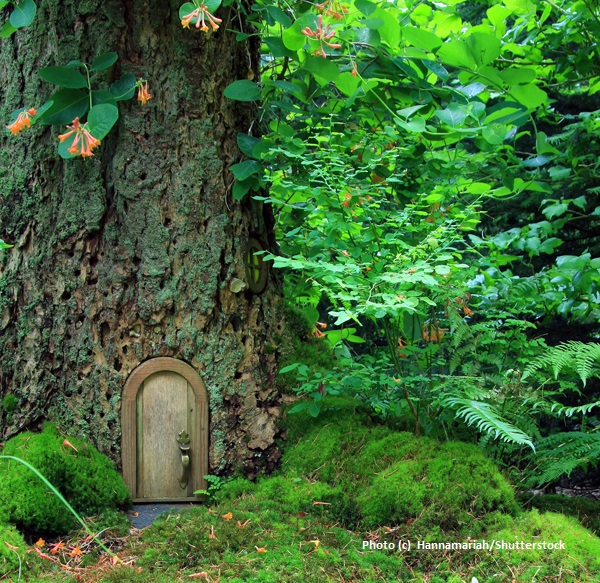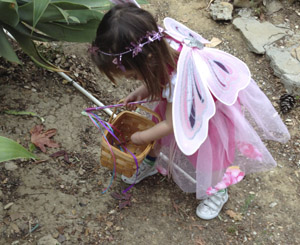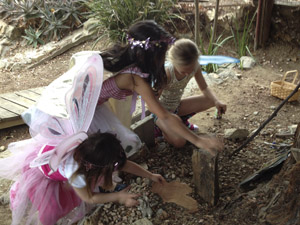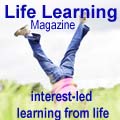 |
When we take a walk or stroll through the woods, beauty surrounds and magic abounds. Treasures are everywhere, waiting to be discovered on ground and in air. Oftentimes, children and their families take walks around their neighborhoods or play in the local city and state parks without even paying much attention to the natural materials all around them. Whether you are a teacher, parent, or a friend, you can encourage the children in your life to take a closer look in order that they may see the potential for crafting, building, and experimenting with materials created naturally by the earth. When children slow down and look carefully, Mother Nature’s treasures present themselves almost magically! A really fun and creative way to use the materials found is to create Faery houses with them. Children’s collection and use of natural materials, combined with the designing and building of the Faery houses, helps them create relationships with the Faeries, the earth, and each other, supporting their physical, social, cognitive, emotional, and creative development. As Jane Williams Siegfredsen from Viberg University in Denmark puts it, “The outdoor environment enhances the understanding of social relationships, language, physical movement, reasoning, curiosity, and the potential to imagine possibilities.” Searching for Faery Treasures Children can begin their search for Faery treasures by going for a walk in any outdoor natural place. Encourage them to pay attention to what seems to catch their eye. It’s kind of like a game of Eye Spy! The collection of the materials can be translated into a full-body sensory experience by encouraging the children to explore the materials thoroughly and unabashedly. For example, asking opening-ended questions such as “What does the acorn smell like?” “How does it feel?” “What do you notice about the shape of the acorn? “What are the colors you see?” “I wonder why some acorns are bigger or smaller than others?” or “I wonder how we could use this in the building of our Faery houses?” encourages children to pay attention to the details, patterns, shapes, smells, sights, and sounds of the natural world around them.
When children explore the materials around them with all of their senses, they gain a deeper understanding of what the material is and how it can be utilized to its fullest capacity in the design and construction of their Faery houses. In an article entitled Promoting Creativity for Life Using Open-Ended Materials by Walter F. Drew and Banji Rankin, it is stated, “The more children use open-ended materials, the more they make them aesthetically pleasing, by fiddling, sorting, and ordering the materials, the more they see the potential in the materials and in themselves. Knowing your materials is the absolute basis for science and for art. You have to use your hands and your eyes and your whole body in order to make judgments and see potential.” Another way to support children in developing relationships with and appreciation of materials is through the sorting and classification of the materials they collect. They can chose to sort the materials by color, shape, use, size, weight, or any other criteria they come up with. The categorization and classification of materials supports the categorization and organization of the brain. The California Department of Education cites on its website that “the ability to classify materials underlies much of cognition. Classification is a fundamental skill in both problem-solving and play.” Through the collecting, exploring, and sorting process, children will become more familiar with the natural world around them. Chances are they will find more and more treasures revealing themselves in the least expected places and will become more present to the gifts the Earth has to offer. They may begin to notice the song of a bird or the colors of spring. They may begin to notice almost everything! The more they explore and collect exciting and diverse materials, the more they will see the inherent potential to create homes and play spaces where the Nature angels can live, play, and be free! Rocks, pebbles, shells, seed pods, flowers, acorns, pine needles, sticks, pine cones, and so much more can all be used conjunctively in the open-ended exploration and building of homes for children’s Faery friends. Due to the variety of natural materials the earth generously provides, children have at their fingertips infinite possible materials to work and create with. They also begin to develop relationships with Earth herself. It is through these relationships that a true, deeper connection as well as an under tanding of the variety of textures, designs, and colors that are a part of Mother Nature’s treasure chest takes place. According to Cathy Weisman Topal, coauthor with Lella Gandini of the book Beautiful Stuff, “Children develop power when they build individual relationships with materials. When children have the chance to notice, collect, and sort materials, children become artists, designers, and engineers.” Designing the Faery House Once your child feels she has gathered enough wonderful materials to build a Faery house, it is time for the real fun to begin! The next step is the designing and building of the Faery house. Some examples of helpful tools to have handy in order to support a successful design and building process are rulers, wire, yarn, twine, scissors, wire cutters, wood glue, clipboards, paper, erasers, multi-colored sharpies, and scales. When children are thinking about the design of their Faery houses, it is often helpful for them to draw the design first. Keeping in mind the characteristics and qualities of the materials collected, children can draw their thoughts and ideas regarding what their Faery house is going to look like. After they are done drawing, comes the transference of the design into form. When children are first beginning the building process, they also have to think about the size, shape, weight, and height of the materials they have collected, as well as how they can combine those materials in ways that will result in the successful construction of a house. When children design and build beautiful Faery house structures using the materials they have found, it is as though a whole new world has opened up for them. Inspired by the different ways to use their materials, children daringly and curiously begin to explore and experiment with how various materials might fit together to create the puzzle they are constructing in beautiful, magical, and complex ways. Throughout the building process, children can be supported in exploring the physical attributes of the objects through the use of a scale or their very own sensory perceptions. By asking questions using comparative vocabulary such as, “Which object is bigger/smaller? Which is heavier/lighter? Smoother/Rougher? Longer/Shorter? Wider/Narrower,” you are supporting your children in discovering and uncovering the traits and attributes of the objects they are using, ultimately helping them in coming up with their own answers to the characteristics, qualities, and uses of these natural materials for the purpose at hand. Construction Begins Through collaboration in building individual or joint Faery houses, children can support as well as scaffold each other in coming up with solutions to various structural challenges, cheer one another on through their architectural triumphs, as well as learn how to work together successfully with a small group of children while gaining valuable critical thinking and conflict resolution skills. For example, one of the children may decide they would like to use a piece of bark they have collected from a nearby tree as a door for their Faery house. The child may first want to measure the piece of bark as well as the space the new door will be fitting into. The child needs to know what the size the door needs to be as well as whether the piece of the bark in mind is too big, too small, or just the right size. If the bark is too big, the children will need to mark how much they will be cutting off in order for the door to fit in the allotted door space. If the piece of bark is too small, the child may either need to find another material with which to make the door or figure out how to add on to the size of the bark. The child may ask his co-constructors if they have any thoughts or ideas as to what material would make the best door. Other children may jump on board, and through this process, critical thinking skills as well as the previous knowledge gained of the various attributes and characteristics of the materials are applied and taken into consideration.
Once the children have collaborated on the right material(s) to use for their door, as well as consulted the drawn design of their house, they need to decide how to attach the door. Another factor that they also need to think about is whether they would like the door to be mobile or immobile. After sharing their thoughts and ideas with each other, the children decide they will attach the door using sap from a nearby tree. Upon trying out their idea, they realize that while the sap is sticky, it doesn’t keep the door in place and doesn’t allow it to swing open and closed. Next, the children decide to cut a hole in the top of the door. Then they try looping the stem of the leaf through the hole. They secure the stem and door by tying the remainder of the stem to two nearby sticks that are part of the structural support of the house. Just as they are tying the end of the stem to the sticks, the stem breaks. Finally, through collaboration, critical thinking, and problem solving, one of the children gets an idea to loop some twine through the hole in the door, wrapping it tightly around the middle of the same sticks used in the first attempt involving the stem. The children cheer and excitedly begin working on other parts of the house, eagerly sharing their ideas as well as helping each other through challenges along the way. Through trial and error, the children form predictions and hypotheses about what works and doesn’t work, based on each child’s previous knowledge and life experiences. Layers of Learning In a 2003 statement clarifying their position on creative thought, the Association for Childhood Education International (ACEI) stated, “We need to do more than prepare children to become cogs in the machinery of commerce. The international community needs resourceful, imaginative, inventive, and ethical problem solvers, who will make a significant contribution, not only to the Information Age in which we currently live, but beyond to ages we can barely envision.” As demonstrated above, this is not your typical Faery house. There is the potential for layers upon layers of deep, rich learning to take place. This learning supports children in strengthening their relationships to themselves, the Faeries, and the Earth. Anita Barrows, a clinical psychologist from Berkeley, CA, states, “Fostering children’s identity to include social and personal relationships to Nature improves their empathy and their sense of interconnection with the world-at-large.” This connection to others is crucial for a child’s development. In a series of summaries of the scientific presentations at the National Symposium on Early Childhood Science and Policy, it is confirmed that “emotional wellbeing and social competence provide a strong foundation for emotional competencies, and together they are the brick and mortar that comprise the foundation of human development.” So this collection of natural materials, as well as the design and shared creative process involved in building Faery houses, has the potential to support the physical, social, cognitive, emotional, and creative development of children. It is the successful, healthy development of children in conjunction with the relationships formed with each other, the Faeries, and the Earth that supports them in becoming the leaders of tomorrow as well as the leaders of today. Meghan Mulqueen M.A. is the Creative Director and Founder of the Secrets of the Faeries Company where, along with her Faery team, she facilitates dynamic, creative, and multi-media experiences for children ages three and up all throughout Los Angeles and Southern California. Meghan has worked with children for the past twenty years in a variety of capacities, including as a Preschool teacher, yoga for kids instructor, and workshop leader. When she is not supporting children in learning the Secrets of the Faeries, she works as a Preschool Teacher in Santa Monica, California.
| |








